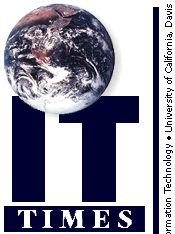
Technology in the Composition Classroom
by Andy Jones, EnglishAs a long-time instructor for the English Department, I have noticed that many of the incoming freshmen at UC Davis feel more comfortable with the computer keyboard than they do with the writing principles of argument, audience, and authentic voice. To introduce these and other elements of composition, the English Department, assisted by Information Technology, offers instructors and students a variety of educational methods that reflect a new generation's interest in advanced technology. Computer classrooms (we don't call them "labs" anymore) in Olson, Surge and Hart Halls have their own internal networks that students use to submit virtual copies of essays to their instructor's class folder; they offer instructors a Macintosh connected to an overhead projector; and they provide instructor and student alike a chance to see others brainstorm, compose and edit prose. In effect, such classrooms invite students to view the supposedly solitary act of writing as an opportunity for co-operative learning and confidence-building. By employing these and other tools, instructors appeal to the learning styles of a diverse student body.
An ambitious computer-assisted instructor might try another kind of multimedia demonstration that appeals to the channel-clicker. Recently, in my Advanced Composition seminar, I played my students the clip from Citizen Kane where Kane shares his newspaper's "Declaration of Principles." After we discussed the film's connection to an essay on popular culture we had just read, I used Microsoft's PowerPoint presentation software to project above me my own ten "Principles of Composition." Although the bright blue letters on the fading purple background might seem a bit hokey, the gimmick of flashy presentation software occupied my students' attention with the substance of my ideas. "Writing well," I summed up to the class after reviewing this top ten list, "comes as a result of curiosity, a solid work ethic, and continual revision." I hope the interest of instructors and the patience of students with the variety of media in a computer classroom will provide both these groups the new tools and inspirations for this "practice" of writing.
I've been pleased with the success of my students, evidenced best by their own instructive use of advanced media in my computer-aided composition classes. Toward the end of this past quarter, students taught their colleagues from the instructor's Mac by projecting examples of the brainstorming, drafting, revising, and editing they completed for their research papers. Students in my Technical Writing class used one of my favorite teaching tools to deliver presentations on the topics of their final projects. While students in the class learned about El Niño, the economics of Microsoft, and the applications of infant sign language, the authors of these reports learned how to create and present documents that are clear, economical, and well-organized. By requiring interaction and public speaking from my students, I remind them what I realize every day that I teach: You never learn anything so well as when you explain it well to someone else. More than ever before, the computer-assisted classrooms at UC Davis allow instructors and their students to do just that.
Andy Jones is a lecturer in the English Department.